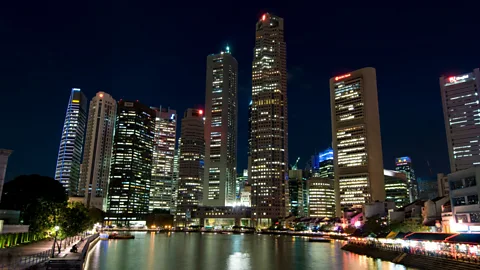
With rising art and music scenes and architecture both new and old, the South East Asian city offers a continuously fresh perspective.
Singapore is small in size but huge in ambition, developing
at a breakneck pace. Its arts and music scenes are similarly on the up, and its
mix of colonial architecture and colourful traditional buildings has never
looked better.
Best for art and
museums
The Asian Civilisations Museum, located in the grand old Empress Place
Building, houses galleries which explore culture, religion and civilisation
from across Asia. Artefacts include a red sandstone Buddha from India,
calligraphy and decorative art, and a display of krisses – daggers said to have
spiritual powers (1 Empress Pl; closed Mon morning; admission £4).
The Ikkan Art Gallery is the biggest hitter among a clutch
of excellent art galleries in the Tanjong Pagar Distripark complex, a short
walk southwest of Chinatown. Ikkan Art displays the work of international
artists in four or five exhibitions a year. Recent ones have focused on new
media art from Beijing-based artist and photographer Miao Xiaochun and Chinese
dissident Ai Weiwei (39 Keppel Road 01–05; closed Sun & Mon;
admission free).
The National Museum of Singapore occupies a 19th-century
building, and its multimedia exhibits focus on the city’s history, culture and
achievements. Visitors can see the natural history drawings of William
Farquhar, an early colonial commandant, and a gallery that celebrates the
city’s street food culture through artefacts and sound installations
(93 Stamford Rd; admission £5).
Best for architecture
The Baba House is one of Chinatown’s best-preserved heritage homes, and
offers a glimpse into the hybrid culture of Singapore’s Peranakan
(Chinese-Malay) minority as it would have been circa 1928. Entertaining, hour-long
tours run four times a week: they’re free, but need to be booked in advance
(157 Neil Rd).
The Raffles Hotel, a colonial edifice that first opened in
1887, is one of the most famous hotels in the world: it’s known for the
Singapore sling cocktail – invented here around 1915 – and remains a byword for
Oriental luxury. Its lobby, bars, outdoor areas and museum, open to the public,
are among Singapore’s major tourist attractions, and rightly so. Dress
standards apply, so don’t come in shorts and sandals (1 Beach Rd;
admission free to lobby and museum).
The Kampong Glam district’s gold-domed epicentre is the
Sultan Mosque (Masjid Sultan). First built in 1825, it was replaced 100 years
later with the current structure. The prayer hall can fit 5,000 worshippers; a
red digital clock spoils the atmosphere a little, but at least everybody knows
when to pray. Visitors are shown around most parts of the mosque and tours in
English are available (3 Muscat St; closed to visitors Fri
morning; admission free).
Best for music and
theatre
The Esplanade – Theatres on the Bay is the poster-boy for contemporary
Singapore: the building has been compared to flies’ eyes, a melting honeycomb
and two upturned durian fruit. Its 1,800-capacity hall serves as a venue for
concerts, recitals and performances from the Singapore Symphony Orchestra
(1 Esplanade Dr; orchestra tickets from £20).
Theatreworks is one of the country’s more experimental and
interesting theatre companies. Artistic director Ong Keng Sen has helped to
establish Theatreworks as a champion of intercultural theatre – Singaporean
creatives work together with Western and international contemporaries in dance,
performance art and drama (72–13 Mohamed Sultan Rd;
tickets from around £14).
Unlike many of Singapore’s live music venues, Tab doesn’t
rely on covers bands to keep the punters happy: the focus of this mid-sized venue
is on local talent and songwriters, plus nightly club features and live
concerts from wandering foreign performers. Expect blues, gospel, rock, funk
and an audience as diverse as the music policy (02–29 Orchard Hotel, 442 Orchard Rd; admission free or around £10).
Where to stay
The newly opened Mayo Inn provides good-sized, IKEA-fitted rooms in a converted
1930s shop-house on the edge of the Little India district. More expensive rooms
come with their own roof terrace (from £60; 9 Jalan Besar).
At Naumi Liora (formerly the Saff), three beautifully
renovated 1920s shophouses in Chinatown combine to create an affordable
boutique hotel. Some of the rooms have outdoor terraces (from £120; 55 Keong
Saik Rd).
The New Majestic Hotel is arguably the best of Chinatown’s
boutique hotels. The place offers 30 individually styled rooms done up with a
mix of vintage and designer furniture (from £160; 31-37 Bukit Pasoh Rd).
Transport
BA, Qantas and Singapore Airlines fly from Heathrow to Singapore Changi airport
(from £640). Singapore Airlines also flies from Manchester
with a one-hour layover in Munich. Shuttle buses to the city centre take around
40 minutes (singles £4.60). Taxis make the trip in around
30 minutes, charging in the region of £10–£20. Public transport, in the form of
buses and MRT (subway) trains, is run by two companies, SBS and SMRT. The MRT network also serves the
airport (singles from £1).



